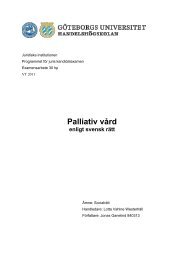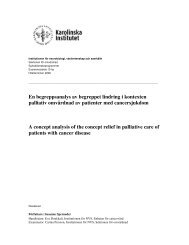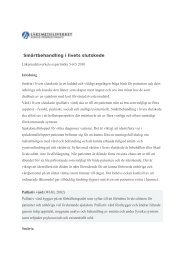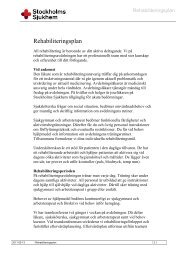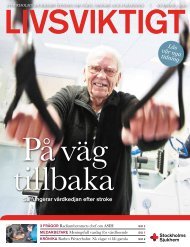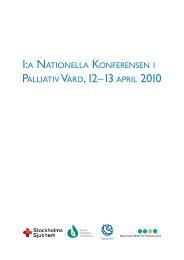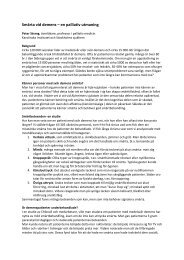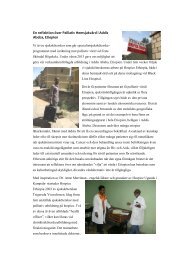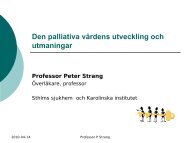Physiotherapy in palliative careâ - Stockholms sjukhem
Physiotherapy in palliative careâ - Stockholms sjukhem
Physiotherapy in palliative careâ - Stockholms sjukhem
Create successful ePaper yourself
Turn your PDF publications into a flip-book with our unique Google optimized e-Paper software.
Physical activity reduces the risk of thromboses, the levels of stress decreases and it works as aprophylaxes for decubitus, improves breath<strong>in</strong>g, keeps the stomach active etc. The exercises canbe done <strong>in</strong>dividually or <strong>in</strong> a group. They can be functional exercises with specific activities, ormore general movement exercises – or general health condition exercises.The goal with physical exercises for cancer patients <strong>in</strong> a <strong>palliative</strong> stage is to ga<strong>in</strong> positiveeffects on general health, strength of muscles, balance, psychological wellbe<strong>in</strong>g, anxiety/worry,depression and quality of life. Focus should be on keep<strong>in</strong>g movement and function.Dosage of tra<strong>in</strong><strong>in</strong>g is important and is diverse for different <strong>in</strong>dividuals. The background ofpeople vary, some have never exercised before where some have had physical tra<strong>in</strong><strong>in</strong>g as a lifestyle. A person who used to run several miles a week might not th<strong>in</strong>k that walk<strong>in</strong>g is exercise,even if the physical ability does not permit runn<strong>in</strong>g. It is therefore important to encourage thepatient to see “here and now” and not to compare with what the patient was able to beforecom<strong>in</strong>g ill.Access to a pool can be valuable. To exercise, movement, strength, balance and coord<strong>in</strong>ation <strong>in</strong>water is weight reliev<strong>in</strong>g and the patient can often perform movements he/she cannot do onland. Us<strong>in</strong>g float<strong>in</strong>g devices movements can be carried out also ly<strong>in</strong>g <strong>in</strong> the water.Many patients can use exercise mach<strong>in</strong>es. Choose some that are functionally well suited andstart on a low level both with weights and the amount of repetition. It is important that thepatient will not become exhausted. Strengthen<strong>in</strong>g exercises with barbells, weight cuffs or rubberbands are good alternatives if the patient is at home or no other equipment is available. Qi gongor yoga are other forms of exercises that prove useful and can also be executed sitt<strong>in</strong>g down.Access to passive cycl<strong>in</strong>g, tilt<strong>in</strong>g table and support for stand<strong>in</strong>g can ease mobiliz<strong>in</strong>g the patient.Even bed bound patients can ga<strong>in</strong> by physical exercise. To be helped to move aga<strong>in</strong>st manualresistance, actively reliev<strong>in</strong>g or totally passive often gives a good feel<strong>in</strong>g.There is strong evidence of positive effects of physical exercises for cancer patients for physicalfunction, muscle strengths, well be<strong>in</strong>g, anxiety, depression and <strong>in</strong> a wide sense quality of life.(22)<strong>Physiotherapy</strong> <strong>in</strong> <strong>palliative</strong> care – a cl<strong>in</strong>ical handbook Ulla Frymark, Lilian Hallgren, Ann‐Charlotte Reisberg 19



